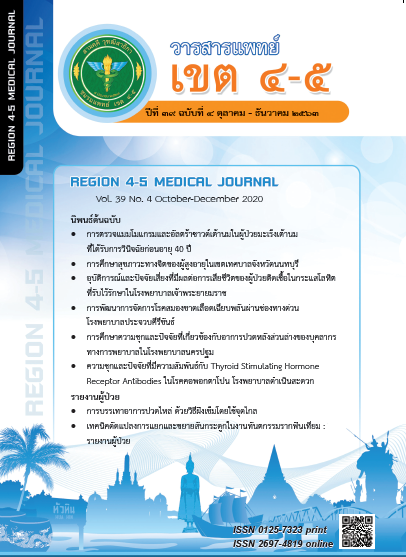ผลการรักษาและปัจจัยสู่ความสำเร็จในการรักษาผู้ป่วยเด็กที่ติดเชื้อเอชไอวี ในโรงพยาบาลนครปฐม ประเทศไทย
คำสำคัญ:
เด็กและวัยรุ่น, ติดเชื้อเอชไอวี, ยาต้านไวรัสบทคัดย่อ
บทคัดย่อ
วัตถุประสงค์: เพื่อศึกษาผลการรักษาและปัจจัยสู่ความสำเร็จของการรักษาผู้ป่วยเด็กติดเชื้อเอชไอวีในโรงพยาบาลนครปฐม
วิธีการศึกษา: ศึกษาย้อนหลังแบบ cohort study ในเด็กและวัยรุ่นที่ติดเชื้อเอชไอวี (0 – 20 ปี) ช่วงเมษายน พ.ศ. 2544 - มีนาคม พ.ศ. 2563 (19 ปี) รวบรวมข้อมูลทั่วไปและข้อมูลทางคลินิก ก่อนและหลังการรักษาด้วยยาต้านไวรัส วิเคราะห์ผลการรักษาและปัจจัยเสี่ยงต่อการเสียชีวิต โดยใช้ paired t-test, chi-square, และ multivariate logistic regression โดยคำนวณ odds ratio ที่ระดับ ช่วงความเชื่อมั่น ร้อยละ 95 และมีนัยสำคัญทางสถิติที่ค่า p < .05
ผลการศึกษา: ผู้ป่วยทั้งหมด 167 คน เพศหญิงร้อยละ 58.1 อายุเริ่มยาต้านไวรัสเฉลี่ย 7.4 4.1 ปี ส่งต่อคลินิกผู้ใหญ่และโรงพยาบาลอื่นร้อยละ 50.8 รักษาต่อในคลินิกเด็กร้อยละ 19.8 ขาดนัดร้อยละ 14.4 เสียชีวิตร้อยละ 15 ส่วนใหญ่ร้อยละ 90.9 รักษาด้วยยาสูตร 2NRTI + NVP/EFV และร้อยละ 62.2 ยังคงยาสูตรเดิม ผลการรักษาสามารถเพิ่มภูมิต้านทาน (จาก CD4 ตั้งต้นเฉลี่ย = 11.1 10.5%, เพิ่มเป็น CD4 สุดท้ายเฉลี่ย = 20.8 11.0%) กดไวรัสลง (จาก viral load: VL > 1,000 copies/mm3 ตั้งต้นพบร้อยละ 81.8 ลดลงสุดท้ายเหลือร้อยละ 46.2 และเพิ่มจำนวนผู้ป่วยที่มี VL < 20 copies/mm3 จากร้อยละ 0 เป็นร้อยละ 53.8) เพิ่มอัตราการเจริญเติบโตทั้งน้ำหนักและส่วนสูง (น้ำหนักและส่วนสูงตั้งต้น จากค่ามัธยฐาน = 10 เพิ่มเป็น 20 และ 40 เปอร์เซ็นต์ไทล์ตามลำดับ) ปัจจัยเสี่ยงต่อการเสียชีวิตดังนี้ 1) การเริ่มยาต้านไวรัสช้าที่อายุ > 5 – 15 ปี มี odds ratio = 3.1, p-value = .044 2) drug adherence ต่ำ มีความเสี่ยงสูงมาก p-value = < .001 (ผู้เสียชีวิตทุกคนมี drug adherence ต่ำ) 3) ระดับ CD4 สุดท้าย < 20% มีความเสี่ยงสูงมาก p-value < .001 (ผู้เสียชีวิตทุกคนมีค่า CD4 < 20%) 4) VL สุดท้าย 20 copies/mm3 มี odds ratio = 2.43 p-value = .001 5) น้ำหนักและส่วนสูงตั้งต้นและสุดท้าย < 3 เปอร์เซ็นต์ไทล์ มี odds ratio = 13.62, 7.34, 20.52 และ 20.23 ตามลำดับ โดยทั้งหมดมี p-value < .001
สรุป: แนวโน้มเด็กที่ติดเชื้อเอชไอวีพบรายใหม่ลดลง การได้รับยาต้านไวรัสทำให้ภูมิต้านทานฟื้นตัว สามารถกดไวรัสได้ เพิ่มอัตราการเจริญเติบโตทั้งน้ำหนักและส่วนสูง ลดการเจ็บป่วย และรอดชีวิตเพิ่มขึ้น ปัจจัยที่ส่งเสริมให้เกิดผลการรักษาดีขึ้น คือ การเริ่มยาต้านไวรัสเร็วที่อายุน้อย ระดับ CD4 ตั้งต้นสูง น้ำหนักและส่วนสูงดี มี drug adherence ดี
เอกสารอ้างอิง
1. สำนักโรคเอดส์ วัณโรค และโรคติดต่อทางเพศสัมพันธ์ กรมควบคุมโรค. แนวทางการตรวจรักษาและป้องกันการติดเชื้อเอชไอวี ประเทศไทยปี 2560 (Thailand National Guidelines On HIV/AIDS Treatment and Prevention 2016). กรุงเทพฯ: สหมิตรพริ้นติ้งแอนด์พับลิสชิ่ง; 2560.
2. ศูนย์อำนวยการบริหารจัดการปัญหาเอดส์แห่งชาติ. มติการประชุมคณะกรรมการแห่งชาติว่าด้วย การป้องกันและแก้ไขปัญหาเอดส์ ปีงบประมาณ พ.ศ. 2555 - 2556. ใน เพชรศรี ศิรินิรันดร์, ทวีทรัพย์ ศิรประภาศิริ, วาสนา นิ่มวรพันธุ์, บรรณาธิการ. กรุงเทพฯ: หกหนึ่งเจ็ด; 2556: 4-5.
3. Diener L, Richardson BA, Chambers EP, et al. Growth reconstitution following antiretroviral therapy and nutritional supplementation: Systemic review and meta-analysis AIDS. 2015; 29(15): 2009-23. doi: 10.1097/QAD.0000000000000783. PMID: 26355573; PMCID: PMC4579534.
4. Liu E, Pimpin L, Shulkin M, et al. Effect of Zinc Supplementation on Growth Outcomes in Children under 5 yr of age. Nutrients. 2018; 10(3): 377. doi: 10.3390/nu 10030377
5. Jesson J, Koumakpai S, Diagne NR, et al. Effect of Age at Antiretroviral therapy Initiation on Catch-up Growth within the First 24 Monthly Among HIV-Infected Children in the JeDEA West African Pediatric Cohort. Pediatr Infect Dis J. 2015; 34(7): e 159-68.
doi: 10.1097/INF.0000000000000734.
6. Mc Grath CJ, Chung MH, Richardson BA, et al. Younger age at HAART Initiation is associated with more rapid growth reconstitution. AIDS. 2011; 25(3): 345-55.doi; 10.1097/QAD.Obo13e32834171db.
7. วิศัลย์ มูลศาสตร์, นฤภัค บุญฤทธิภัทร์, ศวิตา อิสสะอาด. ปัจจัยที่มีผลต่อภาวะล้มเหลวทางไวรัสขณะได้รับยา Lopinavir/ritonavir ในผู้ป่วยวัยรุ่น ณ สถาบันบำราศนราดูร. วารสารกุมารเวชศาสตร์. 2556; 52(1): 61-9.
8. Cauldbeck MB, O’Connor C, O’Connor MB, et al. Adherence to anti-retroviral therapy among HIV patients in Bangalore, India. AIDS Res Ther. 2009; 6: 7. doi: 10.1186/1742-6405-6-7.
9. Polisser J, Ametonou F, Arrive E, et al. Correlates of adherence to antiretroviral therapy in HIV-infected children in Lomé, Togo, West Africa. AIDS Behav. 2009; 13(1): 23-32. doi: 10.1007/s10461-008-9437-6.
10. Kawilapat S, Salvadori N, Ngo-Gians-Huong N, et al. Incidence and risk factors of loss to follow-up among HIV-Infected Children in an antiretroviral treatment program. PLoS ONE. 2019; 14(9): e0222082. doi: 10.1371/journal. pone.0222082.
11. Wanialwa DC, Obimbo EM, Farquhar C, et al. Predictors of Mortality in HIV1 Infected Children on Antiretroviral Therapy in Kenya: A Propective. BMC Pediatr. 2010; 10: 33. doi: 10.1186/1471-2431-10-33.
12. Koller M, Patel K, Chi BH, et al. Immunodeficiency in children starting antiretroviral therapy in low-, middle-, and high-income countries. J Acquir Immune Defic Syndr. 2015; 68(1): 62-72. doi: 10.1097/QAI.0000000000000380.
13. Braidy MT, Oleske JM, Williams PL, et al. Declines in MR and Changes in Causes of death in HIV-1-Infected Children during the HAART era. J Acquir Immune Defic Syndr. 2010; 53(1): 86. doi: 10.1097/QAI.0b013e3181b9869f.
14. Traisathit P, Delory T, Ngo-Giang-Huong N, et al. Brief Report: AIDS-Defining Events and Deaths in HIV-Infected Children and Adolescent on Antiretroviral: A14-year study in Thailand. J Acquir Immune Defic Syndr. 2018; 77(1): 17-22. doi: 10.1097/QAI. 0000000000001571 .
15. Johnson LF, Patrich M, Stephen C, et al. Steep Declines in Pediatric AIDs Mortality in South Africa, Despite Poor Progress Toward Pediatric Diagnosis and Treatment Targets. Pediatr Infect Dis J. 2020; 39(9): 843-8. doi: 10.1097/INF.0000000000002680.
16. Seth A, Malhotra RK, Gupta R, et al. Effect of Antiretroviral Therapy on Growth Parameters of Children with HIV Infection. Pediatr Infect Dis J. 2018; 37(1): 85-89.
Doi: 10.1097/1NF.00000000000017.
17. Dankner WM, Lindsey JC, Levin MJ, et al. Correlates of opportunistic infections in children infected with the human immunodeficiency virus managed before highly active antiretroviral therapy. Pediatr Infect Dis J. 2001; 20(1): 40-8. doi: 10.1097/00006454-200101000-00008.
18. Papi L, Menezes AC, Rocha H, et al. Prevalence of Lipodystrophy and risk factors for dyslipidemia in HIV-infected children in Brazil. Braz J Infect DIS. 2014; 18(4): 394.
19. Mofenson LM, Cohn J, Sacks E. Challenges in the Early Infant HIV Diagnosis and Treatment Cascade. JAIDS. 2020: 84(Suppl1); S1-S4. doi: 10.1097/OAJ.0000000000002366.
20. Desmonde S, Tanser F, Vreeman R, et al. Access to antiretroviral therapy in HIV-infected Children aged 0-19 years in the International Epidemiology Databases to Evaluate AIDS (IeDEA) Global Cohort Consortium, 2004-2015: A prospective cohort study. PLOS Med. 2018; 15(5): e1002565. doi: 10.1371/Journal.pmed:1002565.
21. Fernandez-Luis S, Nhampossa T, Fuente SL, et al. Pediatric HIV Care Cascade in Southern Mozambique: Missed Opportunities for Early ART and Re-engagement in Care. Pediatr Infect Dis J. 2020; 39(5): 429-34. doi: 10.1097/INF.0000000000002612.
22. Traisathit P, Urien S, Coeur SL, et al. Impact of antiretroviral treatment on height evolution of HIV infected children. BMC Pediatrics 2019; 19: 287.
23. Puthanakit T, Kerr SJ, Ananworanich J, et al. Pattern and Predictors of Immunologic Recovery in Human Immunodeficency Virus-Infected Children Receiving Non-Nucleoside Reverse Transcriptase Inhibitor-Based Highly Active Antiretroviral Therapy. Pediatr Infect Dis J. 2009. 28(6): 488-92. Doi: 10.1097/inf.0b013e318194eea6.
24. Tadesse BT, Foster BA, Latour E, et al. Predictors of Virologic Failure Among a Cohort of HIV-infected Children in Southern Ethiopia. Pediatr Infect Dis J. 2020. doi: 10.1097/INF.0000000000002898. [Online ahead of print].
25. Bunupuradah T, Sricharoenchai S, Hansudewechakul R, et al. Risk of First-line Antiretroviral Therapy Failure in HIV-infected Thai Children and Adolescents. Pediatr Infect Dis J. 2015; 34(3): e58-e62. doi: 10.1097/INF.0000000000000584.
26. Schroter J, Anelone A JN, Yates AJ, et al. Time to Viral Suppression in Perinatally HIV-Infected Infants Depends on the Viral Load and CD4 T-Cell Percentage at the Start of Treatment. JAIDS. 2020; 83(5): 522-9. doi: 10.1097/QAI.0000000000002291.
27. Benki-Nugent S, Wamalwa D, Langat A, et al. Comparison of development milestone attainment in early treated HIV-infected infants versus HIV-unexposed infants: a prospective cohort study BMC Pediatr. 2017; 17: 24. doi: 10.1186/s12887-017-0776-1.
ดาวน์โหลด
เผยแพร่แล้ว
รูปแบบการอ้างอิง
ฉบับ
ประเภทบทความ
สัญญาอนุญาต
ลิขสิทธิ์บทความเป็นของผู้เขียนบทความ แต่หากผลงานของท่านได้รับการพิจารณาตีพิมพ์ลงวารสารแพทย์เขต 4-5 จะคงไว้ซึ่งสิทธิ์ในการตีพิมพ์ครั้งแรกด้วยเหตุที่บทความจะปรากฎในวารสารที่เข้าถึงได้ จึงอนุญาตให้นำบทความในวารสารไปใช้ประโยชน์ได้ในเชิงวิชาการโดยจำเป็นต้องมีการอ้างอิงถึงชื่อวารสารอย่างถูกต้อง แต่ไม่อนุญาตให้นำไปใช้ในเชิงพาณิชย์




